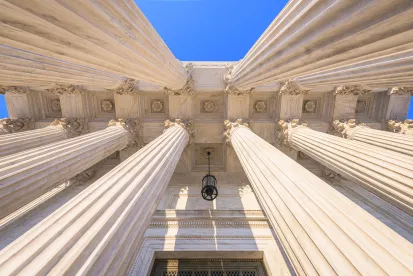Most of the attention this week was on the Court’s final set of arguments for the OT2019 term, including arguments in the two Trump-related subpoena cases. This time, the Court’s teleconference arguments went a bit more smoothly, with fewer un-muted mishaps than last week. Whether the Court will be able to issue decisions in these cases (in which argument was delayed by several weeks due to COVID-19) by its traditional end-of-term date in June remains to be seen, but we’ll be around to provide the run-down when these (and several other) much-awaited decisions come out.
In the meantime, the Court did issue one decision this week in a case that has been closely watched by the complex civil litigation bar. Lucky Brand Dungarees, Inc. v. Marcel Fashions Group, Inc. (No. 18-1086) addressed the rarely litigated but hotly debated question of when the doctrine of res judicata bars a party from asserting a defense it could have but failed to raise in a prior lawsuit. The Court’s unanimous decision avoided delving far into the theoretical debate about whether this “defense preclusion” doctrine should exist at all, while at the same time making clear that only in truly unusual circumstances might a plaintiff be able to prevent a defendant from raising a defense based on its failure to raise it in some prior suit.
This case is a bit long on backstory, so bear with us. Marcel and Lucky Brand both sell jeans, and both use the word “Lucky” in their trademarks. Marcel holds a registered trademark in the phrase “Get Lucky,” while Lucky Brand sells apparel under its registered trademark “Lucky Brand.” The similarity between their marks has spawned decades of trademark litigation over just who can use what marks in connection with which items. This fight began in 2001, when Marcel sued Lucky Brand over its use of “Get Lucky” in advertisements. In 2003, the parties resolved the suit with a settlement agreement in which Lucky Brand agreed to stop using the phrase “Get Lucky” and Marcel released any claims it may have had related to Lucky Brand’s use of its own registered trademarks.
Almost immediately after the settlement was signed, however, round two commenced. In 2005, Lucky Brand sued, alleging that Marcel was copying Lucky Brand’s logos and such in some of its designs. Marcel countersued, claiming that Lucky Brand was still using the “Get Lucky” phrase in its marketing in violation of the settlement. It also asserted that Lucky Brand’s use of “Get Lucky” in close proximity to its “Lucky Brand” mark was confusingly similar to Marcel’s “Get Lucky” mark. Marcel did not allege, however, that Lucky Brand’s use of “Lucky Brand” alone infringed its trademarks. Lucky Brand moved to dismiss Marcel’s counterclaims on the theory that they were barred by the release, but after its initial motion to dismiss was denied without prejudice, it stopped pursuing that defense. Lucky Brand ultimately lost that suit, with the District Court permanently enjoining it from using, copying, or imitating the “Get Lucky” mark and with a jury finding in Marcel’s favor on its counterclaims alleging that Lucky Brand’s use of “Get Lucky” alongside “Lucky Brand” constituted trademark infringement.
2011 saw round three begin, with Marcel alleging that Lucky Brand was violating the judgment entered at the end of the 2005 suit by using its own trademarks, many of which contained the word “Lucky” (but none of which involved the much-litigated “Get Lucky” phrase). After a trip to the Second Circuit and back, Marcel’s claims were clarified somewhat, with the courts construing them as asserting trademark infringement only regarding Lucky Brand’s post-2005 use of Lucky Brand’s own trademarks. With the claims so clarified, Lucky Brand moved to dismiss, arguing that this is just the theory that Marcel had released way back in the 2003 settlement. The District Court agreed. But the Second Circuit reversed. It concluded that Lucky Brand was barred from raising this release defense because it didn’t raise it as a defense to Marcel’s counterclaims in the 2005 suit. (Well, it did, but then it abandoned it.) The Second Circuit concluded that this doctrine of “defense preclusion” prohibited defendants from raising a defense that could have been raised (but wasn’t) in a prior action (1) between the same parties, (2) when that action was adjudicated on the merits, (3) and when a district court concludes, in its exercise of discretion, that such preclusion was appropriate. The Supreme Court granted certiorari to resolve a split among the circuits about the existence and scope of this “defense preclusion” theory.
Justice Sotomayor, writing for a unanimous Court, began with familiar principles of res judicata. While the terminology can be confusing, most contemporary sources view res judicata as consisting of two different but related doctrines. The first, issue preclusion, prevents a party from relitigating an issue that that was actually decided in a prior case (and was necessary to that judgment). The second, claim preclusion, prevents parties from raising claims they could have raised, but didn’t, in a prior case.
Turning to the question before it, Justice Sotomayor noted that the Court’s prior cases had never suggested that so-called defense preclusion was some standalone version of res judicata. Instead, it exists (if at all) only as one particular example of issue or claim preclusion. Thus defensive preclusion can be invoked only where the traditional requirements of claim or issue preclusion are met. The parties agreed that issue preclusion could not apply here—no court had ever decided anything about the scope of Marcel’s release—so the only route was to find that claim preclusion prevented Lucky Brand from raising its release defense. Pointing to some of the academic commentary, Justice Sotomayor observed in a footnote that there are good reasons to question whether claim-preclusion principles should ever prohibit someone from raising a defense (as opposed to an affirmative claim), given the very many reasons why it might not be worthwhile to raise a particular defense in a prior action despite it being available. But it was unnecessary to wade into that thorny question, because Marcel’s claim preclusion argument was not that close. Among other requirements, claim preclusion only applies when the two suits share a “common nucleus of operative fact.” That was not the case here: The 2011 and 2005 suits involved different marks (“Get Lucky” was the core of the 2005 claims, but absent from the 2011 one) and different time periods (the 2011 suit was construed as limited to Lucky Brand’s activities after the 2005 suit was resolved). These and other differences between the two cases meant that claim preclusion did not bar Lucky Brand from raising its release defense now regardless of whether it could (or should) have been raised in 2005.
Trying to resist this result, Marcel repeated the approach of the Second Circuit, arguing that various authorities established a more full-throated defense preclusion doctrine that exists outside the limits of ordinary issue and claim preclusion principles. But Justice Sotomayor wasn’t having it: She quickly brushed aside all of Marcel’s examples, finding them nothing more than straightforward examples of claim or issue preclusion. Thus the Court stopped in its tracks some lower courts’ efforts to develop a new, stronger theory of defense preclusion that could preclude parties from raising defenses even where claim or issue preclusion would not ordinarily apply.
That’s all for this week. We expect the Court will be back in action next week with more decisions, and we’ll be here to summarize them as usual.





 />i
/>i

